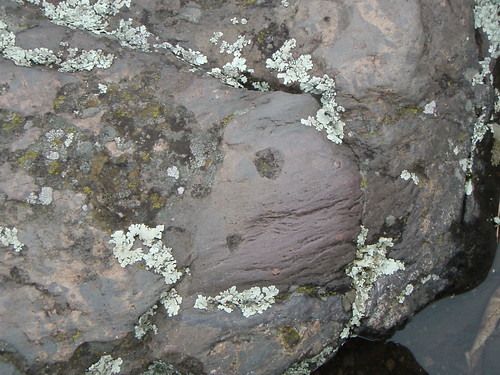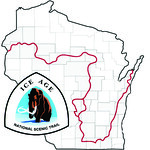The Wisconsinan (and last) episode of the Ice Age ended about 10,000 years ago. This feature is evidence of the glacier at Interstate State Park.
Glacial striations are scratches or gouges cut into the bedrock by coarse rock debris in the bottom of the glacier. They are usually multiple, straight, and parallel to the ice-flow direction. It is common to see more than one direction of striations which indicates there was more than one glacial advance or a change of direction of the ice flow as it advanced. Rocks carried by the glacier, such as those that scratched the bedrock, can also have striations. The striations at this location are believed to be from the Superior Lobe of the Wisconsinan glaciation. They are often less than 0.1 inch wide and deep. The depth of striations may be affected by weathering, but there is no way to precisely date them.
 The striations on Observation Rock are difficult to locate and identify even when you know the location. Look for small areas (3-5 inches in diameter) of smooth rock with slightly deep scratches. The striations in the photo here are just below and to the right of imaginary center lines. The smooth rock surfaces were polished by many very small particles of sand pushed over the surface. The scratches within the polished area were made by slightly larger grains and gravel.
The striations on Observation Rock are difficult to locate and identify even when you know the location. Look for small areas (3-5 inches in diameter) of smooth rock with slightly deep scratches. The striations in the photo here are just below and to the right of imaginary center lines. The smooth rock surfaces were polished by many very small particles of sand pushed over the surface. The scratches within the polished area were made by slightly larger grains and gravel.
If you have the time, be sure to stop by the Interpretive Center to see samples of striations and polished rocks on display. The Center is open most days of the year from 9 am to 4 or 5 pm; winter hours may vary.
 IATCC is the cache designation to highlight a series of EarthCaches along the Ice Age National Scenic Trail grouped into a special category called "ColdCache."
IATCC is the cache designation to highlight a series of EarthCaches along the Ice Age National Scenic Trail grouped into a special category called "ColdCache."
The Ice Age Trail is one of eleven National Scenic Trails designated by the National Park Service. This unique trail is entirely within the state of Wisconsin and follows along the terminal moraine of the most recent glacier which retreated about 10,000 years ago.
This project is supported by the Ice Age Trail Alliance (IATA). The goal is to bring more visitors to the trail and promote public awareness, appreciation, and understanding of Wisconsin’s glacial landscape.
The IATA has created an awards program to encourage visits to the trail and ColdCache sites. This awards program is separate from, and in addition to, any other Geo- or EarthCache awards program.
A current list of approved ColdCache sites can be found on the “IATCC Bookmark List”. More information on the Ice Age Trail Atlas, the Companion Guide, the ColdCache Project and Awards Program can be found on the “ColdCache Webpage”
DNR Permission
The Geocache Notification Form has been submitted to Kurt Dreger of the Wisconsin DNR. Geocaches placed on Wisconsin Department of Natural Resource managed lands require permission by means of a notification form. Please print out a paper copy of the notification form, fill in all required information, then submit it to the land manager. The DNR Notification form and land manager information can be obtained at: www.wi-geocaching.com/hiding
Resources:
Geology of the Ice Age National Scenic Trail; by David M Mickelson, Louis J Maher Jr., and Susan L Simpson.
Wikipedia
To claim this find:
Try to find at least 2 or 3 areas of striations within 10 feet of ground zero.
1. What is the directional orientation of the striations?
2. Based on this information, what direction do you think the glacier was moving when the striations were made?